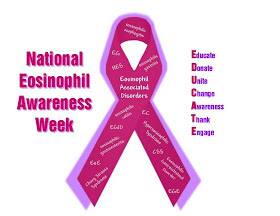This week, May 19th-25th, 2013 is National Eosinophil Awareness Week! If you have followed my blog for a while, then you already know something about eosinophils. If you are a new reader, you can learn a little about Eosinophilic Gastrointestinal Disorders (or EGID), specifically Eosinophilic Esophagitis (or EoE), by reading through some of my earlier posts about our journey with 2 of our daughters and their struggles with EoE, starting with this one.
Eosinophils (E-o-'si-n-o-"fils) are a specific type of white blood cell generally associated with allergies, parasites and cancer. Eosinophil Associated Disorders are a group of uncommon (rare) chronic illnesses. While they are still considered rare, these disorders are rapidly
emerging as a healthcare problem worldwide. Yet, many patients suffering from these disorders go
undiagnosed for years due to a lack of information or awareness of these diseases.
In eosinophilic disorders, a high numbers of eosinophils accumulate in body tissues causing inflammation and damage. These disorders are classified by body tissue where eosinophils accumulate. For example, in eosinophilic esophagitis the eosinophils attack the esophagus.
The only way currently that these disorders can be diagnosed and monitored is by tissue biopsies. What this means is that in order to be diagnosed, my daughters had to go into the operating room and have upper endoscopies and colonoscopies during which multiple biopsies were taken of the tissue throughout the digestive system. Cassidy, pictured here, has been scoped and biopsied at least 10 times (after a while you actually start to lose track) and Chloe, who was only diagnosed a little over a year ago, has been scoped 5 times and hospitalized twice already. In both cases, during the first set of scopes, large numbers of eosinophils were found in the esophagus tissue samples when the biopsies were sent to the lab. The only way to monitor the progress of the disease or the effectiveness of treatments is to repeatedly go back into the O.R. and have more biopsies taken. This will go on to some extent probably for the rest of their lives.
Eosinophilic Gastrointestinal Disorders render the patient unable to tolerate food proteins. Eating food causes damage to the GI tract, pain, and symptoms similar to those you would experience from a
stomach virus. Sometimes the pain is bad enough each and every time they swallow that they just stop eating all together. Yes, really. It gets that bad. Depending on the number of foods that trigger the eosinophilic reaction, some who live with EGID need to stop eating ALL foods just to control the damage and inflammation. In these cases, the patient is given a special amino acid formula through a feeding tube. Chloe was dependent on a feeding tube for 2 months last summer, and truthfully we felt lucky that she was able to stop using it after such a "short" time. Eosinophilic esophagitis can also be triggered by environmental allergens, causing flares that can only be controlled with the extended use of steroids.
 All of these are chronic diseases requiring long term treatment, with no known cure. They are also not something that people who suffer from them will "outgrow".
All of these are chronic diseases requiring long term treatment, with no known cure. They are also not something that people who suffer from them will "outgrow".Sometimes the symptoms can be well controlled with dietary changes, sometimes they require steroids, but the disorders are now believed to be relapsing and remitting, which means that you can have some success with treatment but could then have flares or relapses. During relapses and flares, these are debilitating diseases leading to missed work, school, social outings, etc.
Also, delays in diagnosis are common. Symptoms vary from person to person and can mimic other, less serious diseases. Even now with prevalence of the diseases on the rise, many doctors and nurses have not even heard of these diseases.
Symptoms of EGID can vary depending on the part of the GI
tract affected, and may include:
• Reflux that does not respond to usual therapy
• Dysphasia (difficulty swallowing)
• Food impactions (food gets stuck in the esophagus)
• Nausea and Vomiting
• Diarrhea
• Failure to thrive (poor growth, malnutrition, or weight loss)
• Abdominal or chest pain
• Gastroparesis (delayed emptying of the stomach)
• Poor appetite
• Bloating
• Anemia
If you would like more information about eosinophilic disorders or would like to make a donation to help support research, please visit the American Partnership for Eosinophilic Disorders at www.apfed.org or the C.U.R.E.D. Foundation at www.curedfoundation.org
If you think that you or someone you love may have an eosinophilic disorder, see a doctor!
If you have been recently diagnosed, please find a support group or seek out the online EOS community. Knowing that you are not in it alone can really make a huge difference, especially on the roughest days. You can learn about some of our own experiences with EoE in some older posts and in other blogs around the internet. Most all of us are willing to discuss our experiences.
I welcome comments and messages from anyone with anyone from the EOS community or anyone at all with questions.





